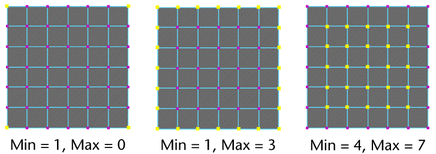Lets you select polygons based on a user-configured constraint filter.
Select > Select Using Constraints
These are the options for the Select Using Constraints feature.
The options that display in the Select Using Constraints option window are dependent on the selection of components in the scene view. That is, you must first select an example of the component type you wish to filter in order to display the related options within the Select Using Constraints option window before you can set the filter options.
At the very top of the window in the Constrain list, you specify conditions to filter your selection actions in different ways. These options apply to all component modes. Click the option to make your selection. Which constraints are applied, and to what settings, is determined by the options you set. There are four different modes:
The following section describes the options you can set for selected components in the properties section of the window.
The following options are applicable to all component types.
Smoothing properties (for edges only)
If you select edges, Smoothing options are made available. These Properties options do not display for any other component type.
Constraint Properties for faces
In addition to the properties that all component modes share, when you are in the face component mode, Maya provides numerous face-specific properties. For example, you can set options to select faces according to order, planarity, and shape— if a polygon is concave instead of convex—as well as mapping and topology.
Order options are used to set a valid range for the shape of the faces. If the following options are on, Maya constrains the selection to what you specify.
Select faces based on whethe they have a hole or not.
If you select non-holed, only faces that do not have holes are selected. If you select Holed, only faces in which holes have been created (using the Mesh > Make Hole Tool) are selected.

Select from various types of problematic faces.
Lets you select faces that cannot be triangulated. Use this constraint option to select these problem faces, then repair them using the Split Polygon Tool (Edit Mesh > Split Polygon Tool). See Split polygon faces for details.
The Min and Max values for most of the Geometry options correspond to the units of a polygonal face. The values you set constrain the selection to the size of the face that corresponds to those units. The default unit size is in centimeters by default. You can change this in the Preferences window (Window > Settings/Preferences > Preferences, then click the Settings category).
In this example, each face of a polygonal primitive plane is four units. You can determine this by looking at the squares of the grid within each face.

When you scale some of the faces and subdivide others, the topology changes as do the Min and Max values you can enter to constrain the selection area.

Try setting different Min and Max values for the Area option for faces, for example, to determine which faces fall within the Min/Max criteria determined by the unit size.

If you set the Area criteria to a Min value of 0 and a Max value of 7, all faces are selected because there are no faces with a unit area less than 0 or greater than 7.

If you want to constrain the selection for a unit area that is very small, such as the area under the eyes on a polygonal modeled face, set the Min and Max values to a small value. The opposite is true if you want to set the constraint area to the cheeks of the face where the faces cover more unit space.
Options common to all Geometry sections (Activate and Off)
Each section contains an Activate switch or an Off option.

Maya selects the faces with an area that is within the range specified in the Min and Max boxes. See Min and Max values for details about using these values.
Neighbors options for vertices and UVs

Maya selects the vertices with no fewer than the Min number of edges connected to them and no more than the Max number of edges connected to them.

Angle options for edges, vertices, and UVs

Maya selects edges based on the angle between the two faces sharing the edge. The possible range of angles is set using the Min and Max values.
Maya selects vertices based on the angle between the edges sharing the vertex. The possible range of angles is set using the Min and Max values.
In the case of UVs, Maya selects them according to the range set for the angle between the edges joining the UVs corresponding to vertices.
These options are used to control the area range of components that are flattened out in the UV Texture Editor window.
These options are used to set a reference point and a valid range for the distance between the component, (such as the face center) and the point you specify.
Visibility options for faces, edges, and vertices
These options are used to set a target point and a focal angle for your selections. Maya selects a component if the target point can be viewed from the center of a face with its normal as the viewing axis (the Px, Py, and Pz values) and the angle as the field of vision.
Grow Selection Region, Shrink Selection Region, Select Selection Boundary buttons
These buttons work the same way as the corresponding Select menu items.